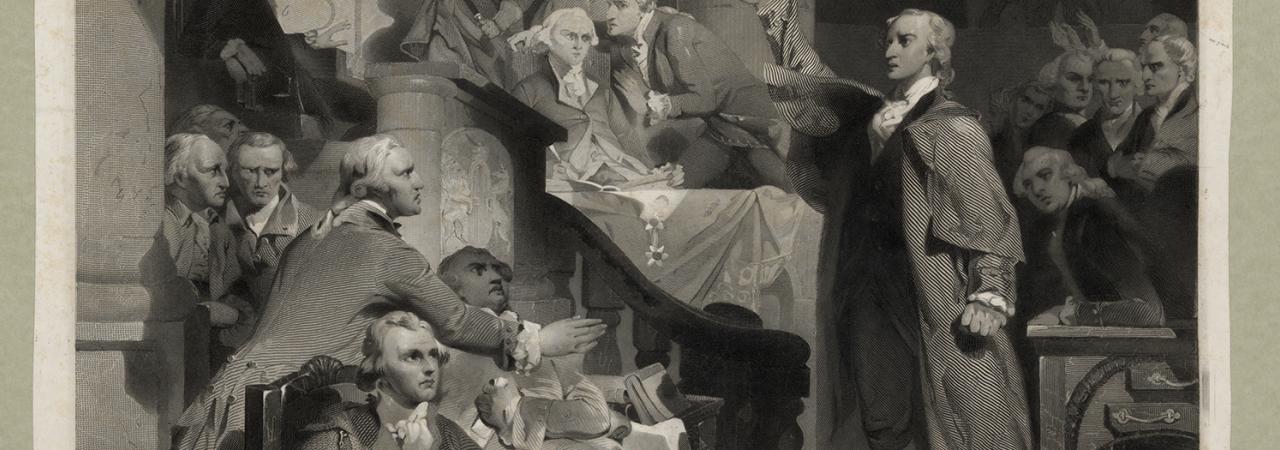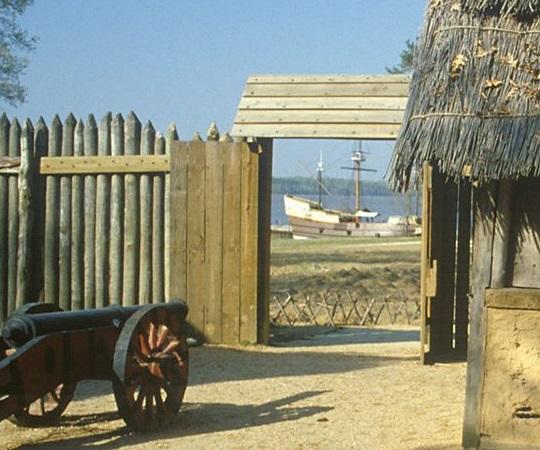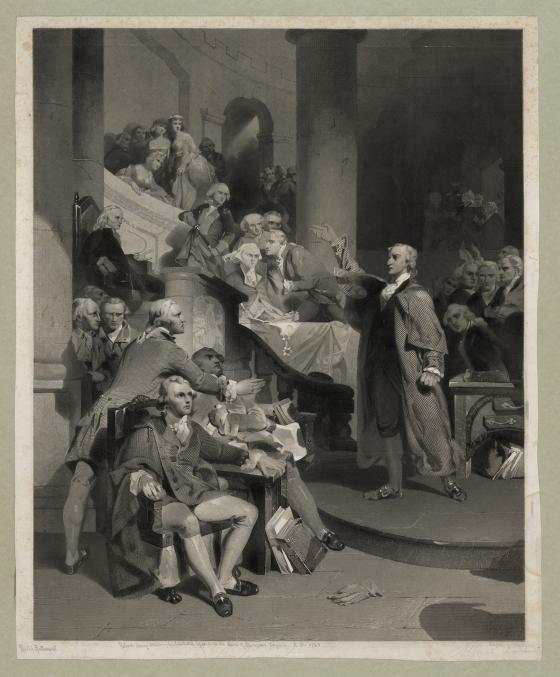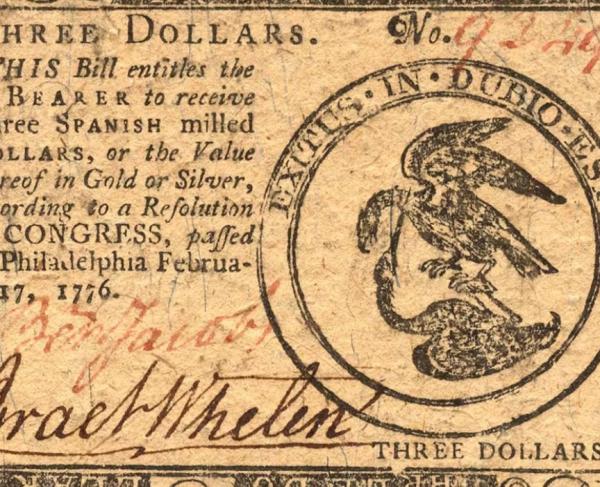
Patrick Henry before the Virginia House of Burgesses on May 30, 1765.
In 2019, Virginia celebrated the 400th anniversary of the first representative legislative assembly in North America. While the idea of representation has continued to be redefined over the course of America’s experiment in democracy, it is important to understand the origins of democratic assembly in the United States, and its birth in the Virginia House of Burgesses.
Establishment and Background
A burgess is simply a member of a governing body. Today we may use the word representative or delegate. In colonial America, Maryland and Virginia had governing bodies known as the House of Burgesses. The first meeting of the Virginia General Assembly in 1619 established the House of Burgesses in Virginia. Meeting in the wooden church at Jamestown, the General Assembly followed orders derived from the Virginia Company’s “Great Charter” of 1618. The new charter was a necessary next step in the government and regulation of the Virginia colony.

The colony’s first charter allowed for a seven-man council to “govern” the colony, which proved largely ineffective in the early years of settlement from 1607-1609. The next charter, issued in May 1609, allotted for a governor with a body of advisors. This also proved ineffective given that its issue coincided with the deadly “starving time” of the winter of 1609/10. However, this charter gave the governor powers to enact martial law. In 1610, Sir Thomas West, Lord de la Warr, built upon previous regulations set forth by Sir Thomas Gates and constructed the “Laws Divine, Morall and Martiall,” to course-correct the struggling colony. At their core, the laws were designed to enforce discipline and conduct, but ignored the central tenants of English common law under which English colonists understood themselves to be beholden (such as trial by jury).
In 1618, the Virginia Company appointed a new governor for the Virginia colony, Sir George Yeardley. Virginia Company members including Sir Edwin Sandys drafted “Instructions to George Yeardley.” This set of instructions became known as “The Great Charter,” as it abolished the current martial law and allowed for the authority of a royally-appointed governor and council who, in turn, was authorized to appoint a General Assembly. Yeardley complied with the instructions for “two Burgesses from each Plantation freely to be elected by the inhabitants thereof.” The General Assembly, then, would “establish one equal and uniform government over all Virginia” for the purpose of passing “just laws for the happy guiding and governing of the people there inhabiting.” At that time the colony consisted of eleven jurisdictions from which 2 burgesses were each elected.
After the initial elections, the House of Burgesses met in the wooden church at Jamestown on July 30, 1619. John Pory served as speaker of the assembly. It is important to note that the directions to Yeardley stipulated that the elected burgesses must meet in assembly with the governor and his six-men advisory council, as well as the treasurer and secretary of the colony. This first meeting ran for 6 days, during which upwards of 30 men endured such conditions inside the church that two men were caused to become ill, and one burgess died on the third day “by reason of extreme heat.” Nonetheless, the proceedings were dubbed a success. The next year, members of the Virginia Company wrote “having pursued the Acts of the general assembly…found theme in their greatest part to be very well and judicially carried and performed.”
Evolution and Challenges
The House of Burgess and joint assembly of the colonial governor and his council faced challenges throughout the years. When King James I revoked the charter of the Virginia Company in 1625, Virginia became a royal colony. The assembly waited for instructions from the king but they were slow to come. Charles I officially recognized the powers of the assembly in his appointment of Sir Francis Wyatt as colonial governor in 1639. An important change came about in 1643 when Governor Sir William Berkeley allowed the House of Burgesses to meet separately, without the assembled governor or council. This created a two-system (bicameral) legislature for the first time in Virginia’s history.
The House of Burgesses grew in importance during the English Civil Wars (1642-1648) when Berkeley and the Assembly were forced to surrender to the new English government after the disposal of Charles I. Under this new authority, the Burgesses were authorized to select a governor and council. In 1660, the Burgesses restored Berkeley as governor. Some of the progress the House of Burgesses were able to make in this period were repealed by Charles II in the wake of Bacon’s Rebellion. Further, James II removed the Burgesses’ right to select governors and council members. The House of Burgesses moved from Jamestown to Williamsburg when the seat of government transferred there in 1699.
Eighteenth-Century and Toward Revolution
With the governor now being a crown appointee, members of the House of Burgesses lost political power. Further, suspicion grew that as royal governors appointed burgesses to important posts, this would unfairly influence the activities of the House. The House attempted to pass legislation to enact a sort of checks and balances, whereby a Burgess appointed to an additional post by a royal governor was required to resign as burgess. Throughout the 18th century, the House continued to meet, and began to see itself as a Parliamentary equivalent in Virginia.

Toward the middle of the 18th century, the House of Burgesses regained some authority as many took up the cry of colonists who felt that their interests were not represented in Parliament in London. Many future founding fathers, including George Washington, Thomas Jefferson, and Patrick Henry began their political careers as burgesses. Before he achieved “give me liberty or give me death,” fame, Patrick Henry presented his Stamp Act Resolves to the House of Burgesses on May 29, 1765. In his resolves, Henry argued that the only authority authorized to levy taxes on Virginia colonists was the General Assembly itself, lest “British as well as American freedom” be destroyed.
In 1774, the House of Burgesses ran afoul of the royal-appointed governor John Murray, earl of Dunmore. On May 24 the House passed a resolution designating a Day of Fasting and Prayer in support of the city of Boston. In the resolution, the burgesses noted it was “highly necessary that the said first Day of June be set apart by the Members of this House as a Day of Fasting, Humiliation, and Prayer, devoutly to implore the divine Interposition for averting the heavy Calamity, which threatens Destruction to our civil Rights[sic], and the Evils of civil War; to give us one Heart and one Mind firmly to oppose, by all just and proper Means, every Injury to American Rights…” So incised was Dunmore that he dissolved the Assembly immediately.
The burgesses continued to meet extra-legally in secret locations around Williamsburg, including the Raleigh Tavern, to discuss their next course of action. From these meetings came the Virginia Conventions, wherein many of the elected members were former burgesses. The first four conventions largely dealt with how to plan for the defense of the colony in the event of war, including establishing the Committee of Safety. The fifth Virginia Convention in 1776, however, formally declared the relationship between Virginia and King and Parliament “totally dissolved,” and instructed the Virginia delegates to the Second Continental Congress to vote in favor of a resolution on independence. This convention also made allowances for the establishment of the Virginia Declaration of Rights and a state constitution. The new Virginia state constitution, ratified in 1776, nullified Virginia’s previous colonial-era government, including the House of Burgesses. It create a bicameral state legislature, allowing for citizens to elect members to a Senate and a House of Delegates.
Legacies
It is important to note the limitations of representation as reflected in the past. From its beginnings in 1619, this first legislative body consisted only of free, white male land owners. In many ways, their legislation reflected the needs and priorities of individuals just like them. Virginia’s House of Burgesses is remembered as the first representative legislative body in English North America, though the importance of representation in government continues to evolve.
Further Reading:
- A Little Parliament: The Virginia General Assembly in the Seventeenth Century By: Warren Billings



